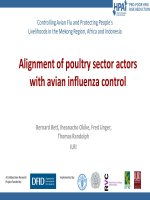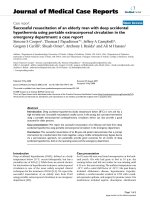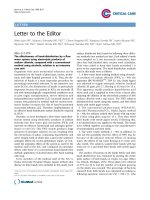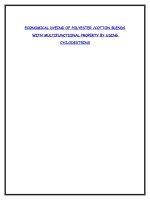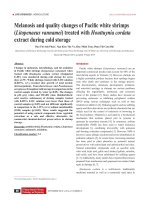Granulation of cocoa powder incorporated with green tea extract using fluid bed drier
Bạn đang xem bản rút gọn của tài liệu. Xem và tải ngay bản đầy đủ của tài liệu tại đây (372.14 KB, 7 trang )
Int.J.Curr.Microbiol.App.Sci (2019) 8(1): 556-562
International Journal of Current Microbiology and Applied Sciences
ISSN: 2319-7706 Volume 8 Number 01 (2019)
Journal homepage:
Original Research Article
/>
Granulation of Cocoa Powder Incorporated with
Green Tea Extract Using Fluid Bed Drier
P. Harini*
Food Technology, Centre for Biotechnology, Alagappa College of Technology,
Anna University, Chennai-600 025, India
*Corresponding author
ABSTRACT
Keywords
Fluidized bed dryer,
Granulation, Green
tea extract,
Antioxidant,
Polyphenol content
Article Info
Accepted:
07 December 2018
Available Online:
10 January 2019
The developments of granules incorporating green tea extract with cocoa powder using
fluidized bed dryer. The product is more concern to the polyphenol is abundant
micronutrients in our diet, and evidence for their role in the prevention of degenerative
diseases. The antioxidant properties are present more in the vegetables and fruits and as
their intake are not consumed due to in conveniences and lack of time. This type of mix
granules will provide sufficient intake of the antioxidant to the required amount by RDA
of the daily intake of the polyphenol, major flavonoids components, and antioxidants
contents. All the sources which are added to the granules are rich sources of antioxidants.
To enrich this property to the product cocoa powder was selected and added. To mask of
the bitterness of product two sugar components were added palm sugar and honey. The
comparison was done between them and palm sugar was more acceptable according to
sensory attributes. Antioxidant property and polyphenol contents were compared with the
products before the designing of the lid and after designing. At each stages of the addition
of components polyphenol and antioxidants was determined and compared. The result
showed granules formed with the honey were much bigger when comparing to the
granules formed by palm sugar. The flow rate of the liquid sample was optimized to set
rpm at 2.5 – 3 in the peristaltic pump with the flow rate of 0.192 – 0.228 l/hour
respectively. The pressure for spraying the liquid sample was set to about 1.2 psi.
which inactivates the enzyme to prevent the
enzymatic oxidation of catechins.
Introduction
Green tea
Cocoa
Tea is an infusion of the leaves of the
Camellia sinensis. It is one of the most widely
consumed beverages after water. Green tea is
made from more mature tea leaves by
withering followed by steaming or firing
Cocoa exhibited the highest antioxidant
activity among the samples in DPPH assays,
with 836 mg/serving. Their results suggest
that cocoa is more beneficial to health than
556
Int.J.Curr.Microbiol.App.Sci (2019) 8(1): 556-562
teas and red wine in terms of its higher
antioxidant capacity.
Honey
Honey is a great natural source of
carbohydrates which provide adequate energy.
It is known that honey has also been found to
keep levels of blood sugar fairly constant
compared to other types of sugar. Honey’s
antioxidant and antibacterial properties can
help improve digestive system and helps to
stay healthy and fight disease.
addition to having antioxidant properties,
polyphenol shave several other specific
biological actions that are as yet poorly
understood. Two aims of research are to
establish evidence for the effects of
polyphenol consumption on health and to
identify which of the hundreds of existing
polyphenols are likely to provide the greatest
protection in the context of preventive
nutrition. If these objectives are to be attained,
it is first essential to determine the nature and
distribution of these compounds in our diet.
Materials and Methods
Palm sugar
Materials for product
Palm sugar as one of the natural sugar sources
can be obtained from most of palm trees such
as coconut, aren, nipah, and siwalan.
Granulation
Granulated or agglomerated particles are more
desirable than fine powders for several
reasons. Improving flow properties of the mix
and hence the uniformity of the dose,
Increasing the bulk density of a product.
Facilitating
metering
or
volumetric
dispensing, Improving product appearance, To
improve flow ability and To improve
dispersibility
Green tea extract: To 5g of the dried green tea
leaves 100ml water was added and heated up
to 60min in 60°c, the crude extract was
collected. About 2.5g of total solid of green
tea was added in 50ml of the extract.
Cocoa powder
Palm sugar
Honey
Soya powder
Granulation using fluid bed dryer
Fluid bed granulation
Methodology and design
Fluidization is the operation by which fine
solids are transformed into a fluid like state
through contact with a gas. At certain gas
velocity, the fluid will support the particles
giving them free mobility without entrapment.
The weighed amount of the dry samples were
loaded in the glass tub enough air blow set
between 30-40 of velocity 2.48-3.48m/s
through a bed of particle, the particle bed may
assume a fluid-like state (resembling a boiling
liquid). Heating the incoming air and
managing air flow rate through the sample at a
set temperature of 60°C and the inner
atmospheric temperature inside the glass tub
was measured with a temperature probe which
was optimized 35-30°C; the Fluid Bed Dryer
provides thorough mixing and maximum
Polyphenols and antioxidants
Polyphenols, which constitute the active
substances found in many medicinal plants,
modulate the activity of a wide range of
enzymes and cell receptors. In this way, in
557
Int.J.Curr.Microbiol.App.Sci (2019) 8(1): 556-562
contact of solid with moving air. The liquid
samples were injected to inlet of the stainless
steel lid through tubes and connect to the
spraying nozzle which is made of Teflon
materials. Two nozzles were designed for
trails as shown in the Graph 2 and 3, the
narrow nozzle shown in figure resulted in
perfect spraying tool (Table 1 and 2).
Peristaltic pump was optimized at a set rpm of
2.5 - 3 at a flow rate of 0.192 - 0.228 l/hr
respectively of the liquid. For the spraying of
the liquid sample air compressor was
optimized to a pressure of 1.2 psi and tubes
were connecting accordingly for the spraying
of the liquid sample for the granulation. The
time interval was set to every 20min for
monitoring the fluidization process and till the
granules formed different samples. The
formed granules were then collected and
analyzed for further studies.
Analysis of antioxidant and polyphenols
DPPH radical scavenging assay
The DPPH assay provides basic information
on the antiradical activity of the health mix.
The actual reaction that is taking place
between the DPPH stable radical and the
antioxidant (AH) is
neither like nor dislike, 9 = like extremely was
used.
Results and Discussion
The formulation was more dependent on the
formation of the granules. The products with
honey were larger size and the colour was also
dark brown, with the palm sugar the granules
were more stable. The size of the granules was
not fully homogenized. The time consumed
for drying the product with honey was more
then with palm sugar. Due to the off flavor of
the soya powder the composition was reduced
to one fifth and the taste was better with
roasted soya. The soya was roasted at 60°C for
10min with continuous stirring. There was
loss of the yield % of the product development
due to the stickiness of the binding
components.
The total polyphenol content of the product
developed granules were calculated and were
compared at different stages of addition of the
sugar components. From the graph.2 and
graph.3 the result clearly shows that the
granules with addition of only sugar
components (palm sugar and honey) were
having lower total polyphenol content than the
components with both protein and sugar
components. This is due to the polyphenol
content present in those components.
DPPH * + (AH) n DPPH-H + (A*) n
Other Biochemical parameters includes,
Proximate analysis, Moisture analysis,
Carbohydrate analysis, Crude protein analysis
(Kjeldahl method), Crude fat content (Soxhlet
extraction), Total ash and Sensory evaluation
were analysed and reported.
Taste, after taste, texture and overall
acceptability of the health drink with addition
of hot milk were evaluated. A nine point
hedonic scale with 1 = dislike extremely, 5 =
The antioxidant property of the products when
compared with the control green tea extract
was less. The product with roasted soya and
palm sugar was obtained a high yield of
66.08%. The lowest of all was the with soya+
palm sugar 21.15% The total polyphenol with
green tea extract and other products and it was
found to be that the polyphenol content was
more in green tea extract 17.29% but to the
next it was with a highest of other 12.68%
with roasted soya + palm sugar* (Table 3-5)
558
Int.J.Curr.Microbiol.App.Sci (2019) 8(1): 556-562
Table.1 Formulation of granulation before designing of fluid bed dryer with sugar components
Sl. No.
1.
2.
3.
Samples taken
Honey*
Palm sugar
ungraded *
Palm sugar
graded*
Weight of the
samples
loaded(g)
50
50
Weight of the
granules after
drying (g)
119.5
109.4
50
Size of the
granules
formed (mm)
4-10
4-8
Time taken in
fluid bed
drying (min)
180
120
4-6
120
105.8
*Green tea extract + cocoa powder (50g+50g)
Table.2 Formulation of granulation after designing of fluid bed dryer
Sl.
No.
Samples taken
Weight of the
samples
loaded(g)
Weight of the
granules after
drying (g)
50+30+5
56.26
40+30+5
57.2
2-4
90
25+25+25
72.5
4-6
100
1. Green tea extract +Palm
sugar +soya powder*
2. Green tea extract +Palm
+roasted soya powder*
3. Green tea extract +honey
+soya powder*
Size of the
granules
formed
(mm)
3-5
Time taken in
fluid bed
drying (min)
80
*cocoa powder (25g)
Table.3 Proximate analysis
Sl.
No
Sample
Fat
content
%
1. Palm sugar +
soya powder*
2. Palm sugar +
roasted soya
powder*
3. Honey + soya
powder*
Ash
content
%
Fiber
content
%
6.7
4.25
3.2
3.3
4.6
8.7
5.8
Protein
content
%
Carbohydrate
content %
Moisture
content
%
9.2
76.86
2.91
2.1
10.1
79.86
2.53
3.6
13.2
68.61
2.70
*Green tea extract + cocoa
Table.4 Colour analysis of the granules
Sl. No.
1.
2.
3.
Sample
Palm + roasted soya*
Palm + soya powder*
Honey + soya powder*
L*
46.49
46.35
48.94
559
A*
7.60
7.82
7.65
B*
11.04
10.97
10.91
Int.J.Curr.Microbiol.App.Sci (2019) 8(1): 556-562
*Green tea extract + cocoa powder
Table.5 Sensory analysis
Sl. No.
1.
2.
3.
4.
5.
Samples
Palm + soya powder*
Palm + roasted soya powder*
Honey + soya powder*
Green tea
Overall acceptance
Overall acceptability
7
8
5
5
6.5
*Green tea extract + cocoa powder
Graph.1 Standard graph for total polyphenol
Graph.2 Total polyphenol content of granules with addition of sugar components
* Green tea extract + cocoa powder
560
Int.J.Curr.Microbiol.App.Sci (2019) 8(1): 556-562
Graph.3 Antioxidant scavenging of granules with sugar component
In conclusion, the study attempted to
investigate the possibility of using fluid bed
dryer the product was optimized for the
granulation with green tea extract, cocoa
powder for the enhancing the taste the sugar
components honey and palm sugar introduced
in and granules were formed. The
comparative study was also done on the basis
of the nutritional analysis of the product. For
the completion of the granulation soya
powder were added to the compared in the
study carried.
control analysis which has enabled the
completion dissertation successfully.
References
Cheng QK and Chen ZM (1994) Tea and
Health. Press Chinese Agri. Sci.,
Beijing, China. Dreosti E (2000)
Antioxidant polyphenols in tea, cocoa,
and wine. Nutrition. 16, 692-694.
Dept. of Biochemistry, SRM Arts and Science
College,
Kattankulathur,
Kanchipuram, Tamilnadu, India A
comparative phytochemical analysis
of cocoa and green tea Indian Journal
of Science and Technology Vol. 3 No.
2 (Feb 2010).
Dreosti IE (1997) Cancer biomarkers in the
field of tea. Cancer Lett. 1,114.
Ki Won Lee, Young Jun Kim, Hyongjoo Lee
and Chang Yong Lee (2003) Cocoa
Has More Phenolic Phytochemicals
and a Higher Antioxidant Capacity
than Teas and Red Wine. J. Agri.
Food Chem. 51, 7292-7295.
Kris‐Etherton, Penny M, Keen, Carl L.
Evidence
that
the
antioxidant
flavonoids in tea and cocoa are
The results were very clearly indicates that
the granules formed were stable and their
acceptability was also good. As per the study
the granules formed between the palm and the
roasted soya powder was more acceptable on
the sensory basis and also with granules
formation.
Acknowledgement
The author acknowledge the help provided by
the Center for Food Technology, Anna
University for his valuable guidance,
constructive criticisms and untiring help and
for utilizing the lab facilities and quality
561
Int.J.Curr.Microbiol.App.Sci (2019) 8(1): 556-562
beneficial for cardiovascular health
Current Opinion in Lipidology
Articles February 2002 - Volume 13 Issue 1 - p 41–49
Manual
of
fluidized
bed
dryer
/>Marina Kobakhidze, Nino Seidishvili
GRANULAR
GREEN
TEA
FOODBALT 2011 Shota Rustaveli
State University, Ninoshvili str.,
Batumi 6010, Georgia
Singleton, V.L., Orthofer, R. and LamuelaRaventos, R.M. Analysis of total
polyphenolics and other oxidation
substrates and antioxidants by means
of Folin-Ciocalteu reagent. In:
Methods in Enzymology. Oxidants
and Antioxidants, Part A, Lester
Packer, ed. (1999), 299, pp. 152-178.
How to cite this article:
Harini, P. 2019. Granulation of Cocoa Powder Incorporated with Green Tea Extract Using
Fluid Bed Drier. Int.J.Curr.Microbiol.App.Sci. 8(01): 556-562.
doi: />
562
